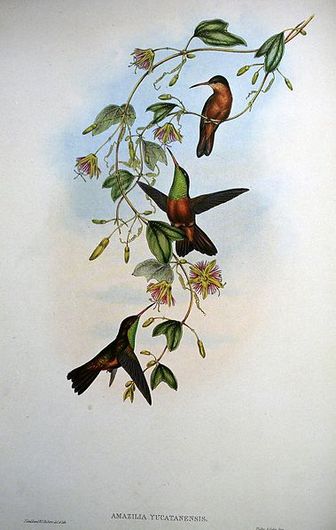Buff-bellied hummingbird
Adults are a metallic olive green above and buffy in the lower breast. The tail and primary wings are rufous in color and slightly forked. The underwing is white. The bill of the male is straight and very slender. It is red in coloration with a darker tip. The throat is a metallic golden green. The female has a dark upper bill, and is less colorful than the male.

The Buff-bellied hummingbird is classified as Least Concern. Does not qualify for a more at risk category. Widespread and abundant taxa are included in this category.
The Buff-bellied Hummingbird, Amazilia yucatanensis, is a medium-sized hummingbird. It is 10–11 cm (3.9–4.3 in) long and has a mass of 4–5 g (0.14–0.18 oz). Adults are a metallic olive green above and buffy in the lower breast. The tail and primary wings are rufous in color and slightly forked. The underwing is white. The bill of the male is straight and very slender. It is red in coloration with a darker tip. The throat is a metallic golden green. More
The Buff-bellied Hummingbird breeds near the coast of the Gulf of Mexico, from south Texas to Mexico. It is probably the least-studied hummingbird that regularly occurs in the United States. More
Habitat: Buff-bellied Hummingbirds occupy a variety of habitats, including woodland edges and urban settings. As a food plant, Buff-bellies prefer the small red flowers of native Turk’s cap (Malvaviscus arboreus) as well as a number of nectar-rich flowers. Best Spots: In the summer season, Buff-bellied Hummingbirds are fairly easy to find in most Valley cities where hummingbird feeders are present. More
- Mexican border, the Buff-bellied Hummingbird breeds in Mexico around the Gulf Coast to the Yucatan Peninsula and south to Guatemala. There is little information regarding population estimates and trends in Texas and Mexico. Ecology The extended breeding season can start as early as March or as late as September. Female lays and incubates 2 white eggs. Female cares for young responsibility until fledging, but timing is not known. Texas population is migratory. More
The Buff-bellied Hummingbird, mainly a Mexican species, may be found among dense tangled thickets and vines in light, open woodlands. It also feeds on flowers in gardens. Unlike most other hummingbirds north of Mexico, the sexes are alike in color. It usually leaves the Rio Grande area in winter and retires southward into adjacent Mexico until the following spring. Physical Description Average weight: male 4.05 g, female 3.67 g. More
Buff-bellied Hummingbird, Amazilia yucatanensis All photos & text More
Bent Life History for the Buff-bellied Hummingbird - the common name and sub-species reflect the nomenclature in use at the time the description was written. BUFF-BELLIED HUMMINGBIRD AMAZILIA YUCATANENSIS CHALCONOTA Oherholser HABITS This is another Mexican species that extends its range northward into the valley of the lower Rio Grande in Texas. More
The Buff-bellied Hummingbird is native to the United States, Mexico, Honduras, Guatemala and Belize. The range of this bird is large, reaching up to 400,000 square kilometers within its native areas. The Buff-bellied Hummingbird has a global population that may be as large as 5 million individual birds. More
Buff-bellied HummingbirdAmazilia yucatanensis The first 3 photos were digiscoped - taken with a Nikon CoolPix 4500 through a Swarovski AT80HD spotting scope. The 4th photo was "snapped" with the Nikon alone when the 'buffy' happened to drop in to the feeder which was quite close - there wasn't time to turn the scope around. More
The Buff-bellied Hummingbird is really a Mexican species that just reaches southern Texas. With its large size and aggressive nature, it usually dominates other hummingbird species at feeders. Besides feeders, Buff-bellied Hummingbirds can also be attracted by sprinklers, in which they will bathe. Buff-bellied Hummingbirds are primarily nectar feeders like most hummingbirds, but also feed on arthropods which they may glean from plants, or even fly-catch in midair. More
The Buff-bellied Hummingbird (Amazilia yucatanensis) is a resident of south Texas and along eastern Mexico. There are rare winter records along the Gulf coast states. Hopefully, we can record our first state record of a Buff-bellied Hummingbird in Georgia soon! Buff-bellied Hummingbird Description: Males and females are colored similarly: Green head, throat, back and breast, belly is buff, tail chestnut, bill is reddish with a black tip. More
The Buff-Bellied Hummingbird is the least studied of hummingbirds indigenous to the United States. For unknown reasons, the Buff-bellied Hummingbird usually flies to the northeast from its breeding areas in the southern part of Texas. This movement is unique among North American hummingbirds. More
Buff-Bellied Hummingbird is known for aggressively defending its nest and territory. Birdfeeders.com is your leading online source for hummingbird feeders, hummingbird nectar, and bird baths. More
The Buff-Bellied Hummingbird occurs in the Rio Grande Valley of south Texas. U.S. Breeding Range: buffbellied map.gif (6585 bytes) Map courtesy of Patuxent Wildlife Research Center, United States Department of the Interior, Laurel, MD. From THE NORTH AMERICAN BREEDING BIRD SURVEY RESULTS AND ANALYSIS, Version 96.3 by J. R. Sauer, J.E. Hines, G. Gough, I. Thomas, B.J. Peterjohn. More
Buff-bellied HummingbirdAmazilia yucatanensis Order APODIFORMES – Family TROCHILIDAE Issue No. 388 Authors: Chavez-Ramirez, Felipe, and Arnulfo Moreno-Valdez * Articles * Multimedia * References Courtesy Preview This Introductory article that you are viewing is a courtesy preview of the full life history account of this species. The remaining articles (Distribution, Habitat, Behavior, etc. More

Original source: ilouque
-ilouque -Author: ilouque
Permission: Some rights reserved
Family : Trochilidae
Genus : Amazilia
Species : yucatanensis
Authority : (Cabot, 1845)

